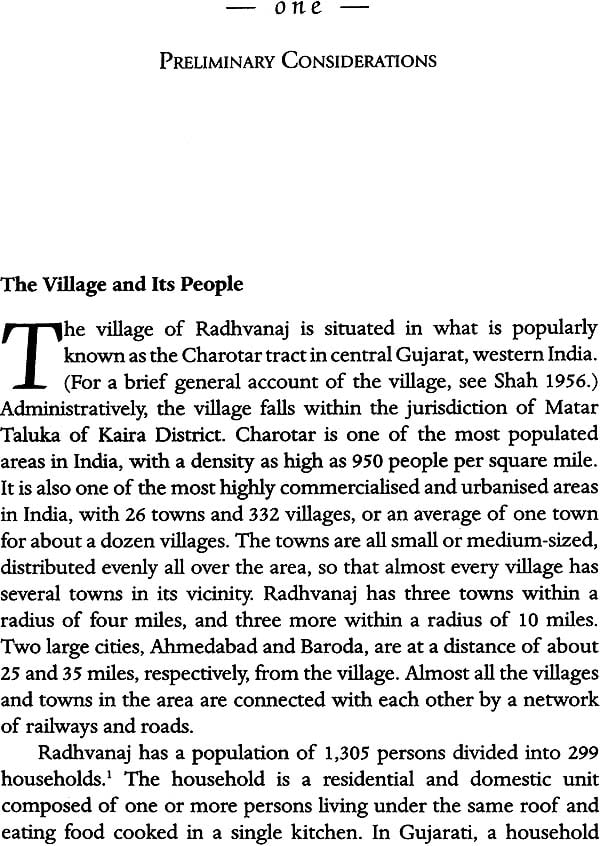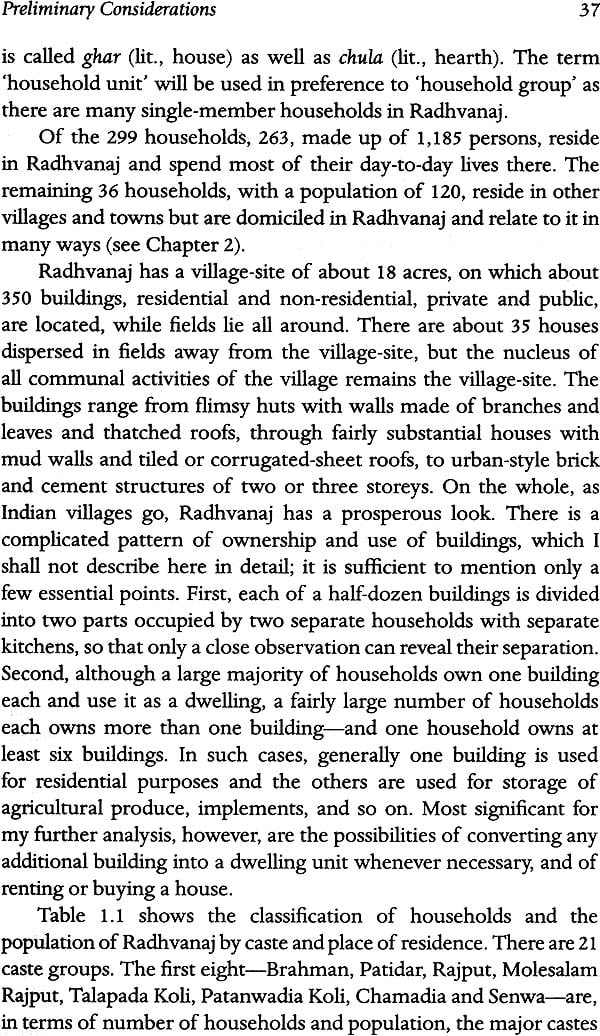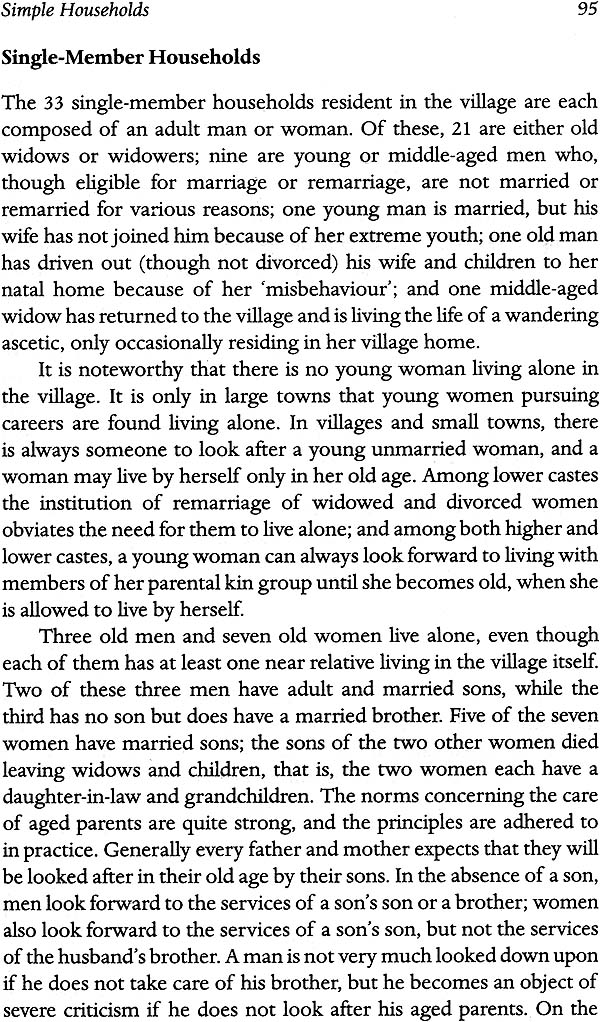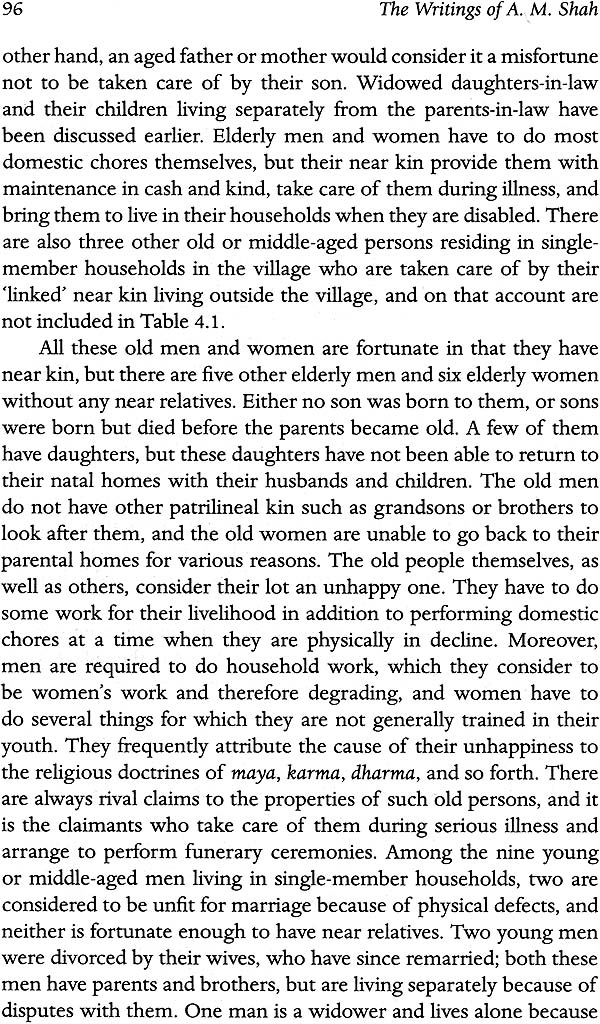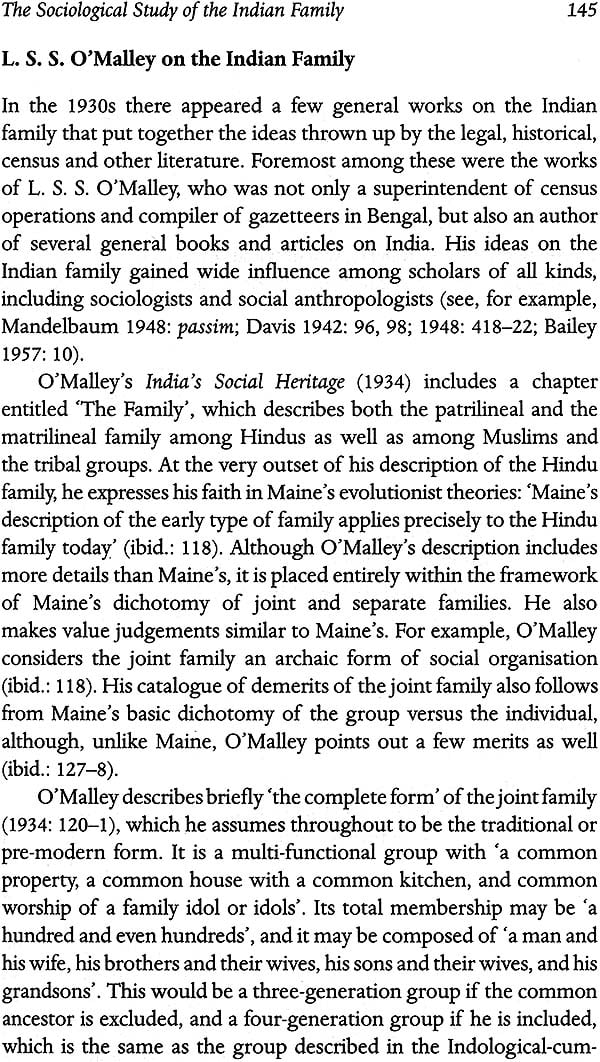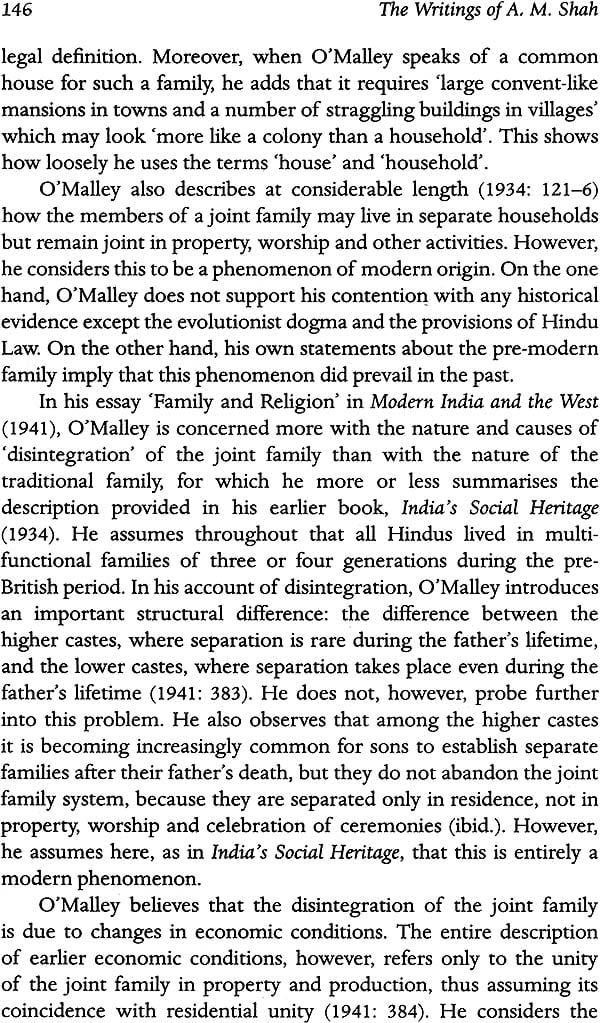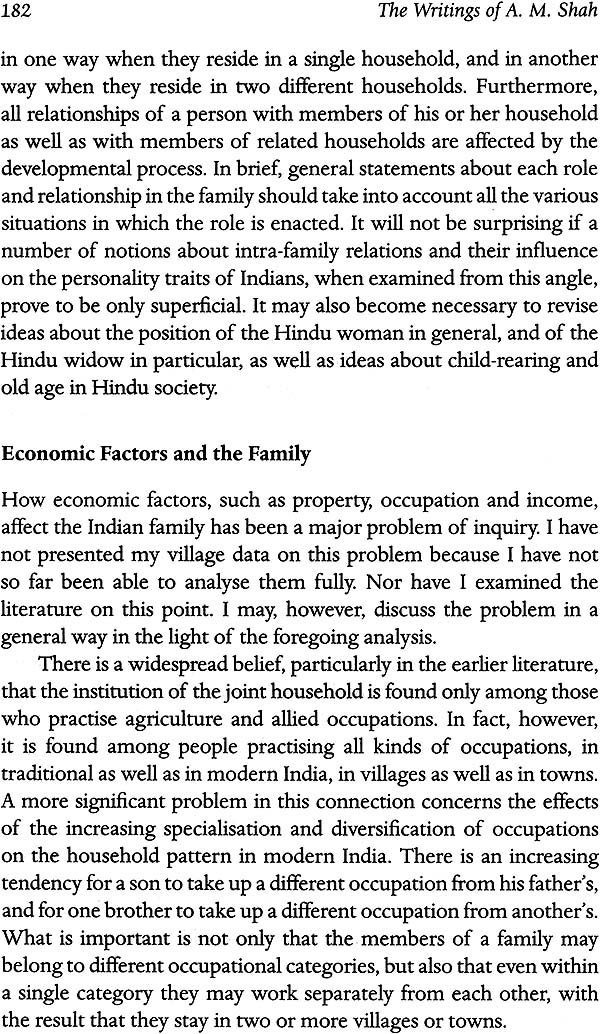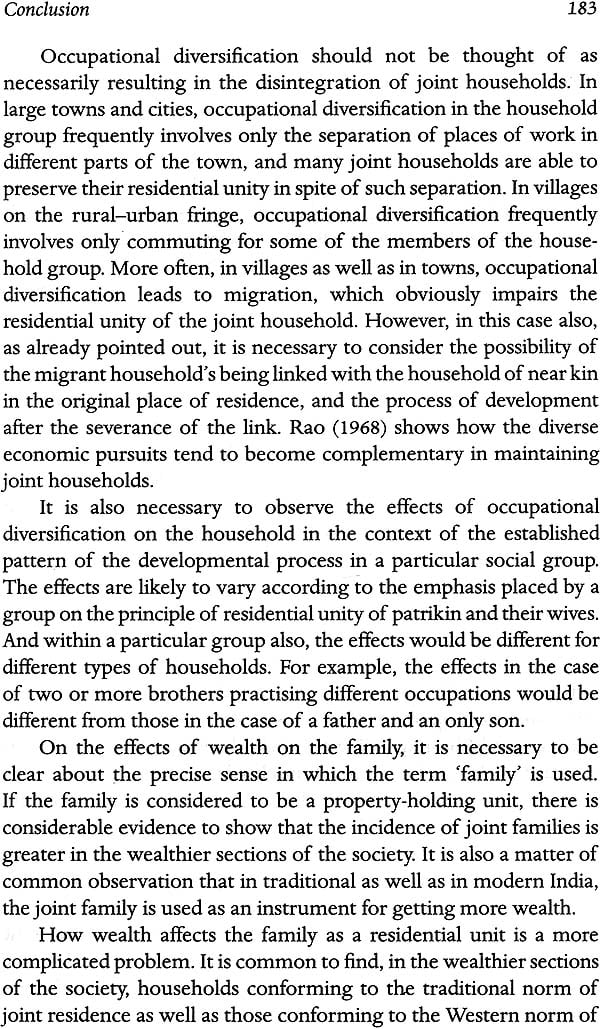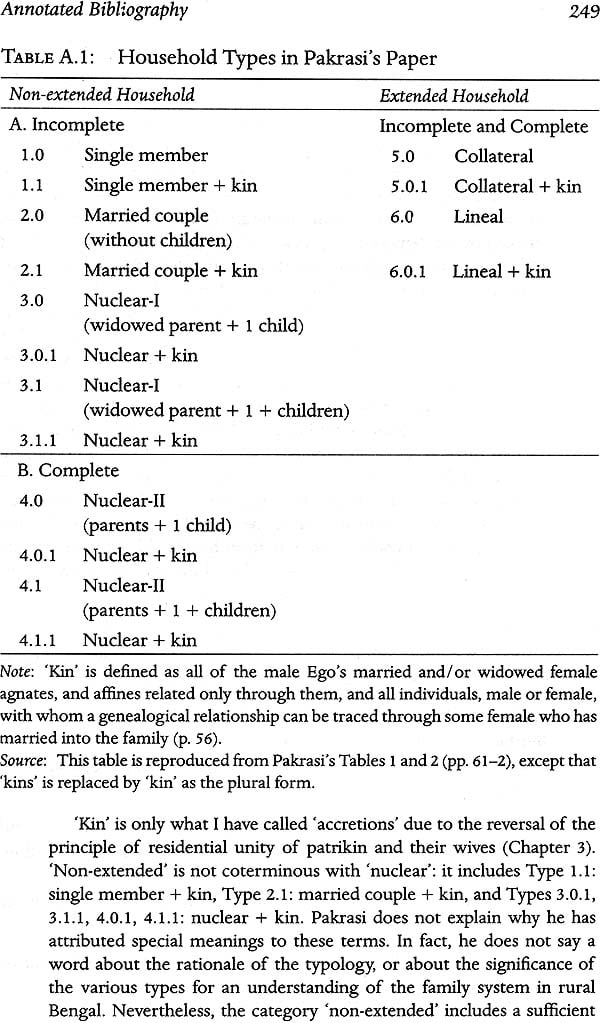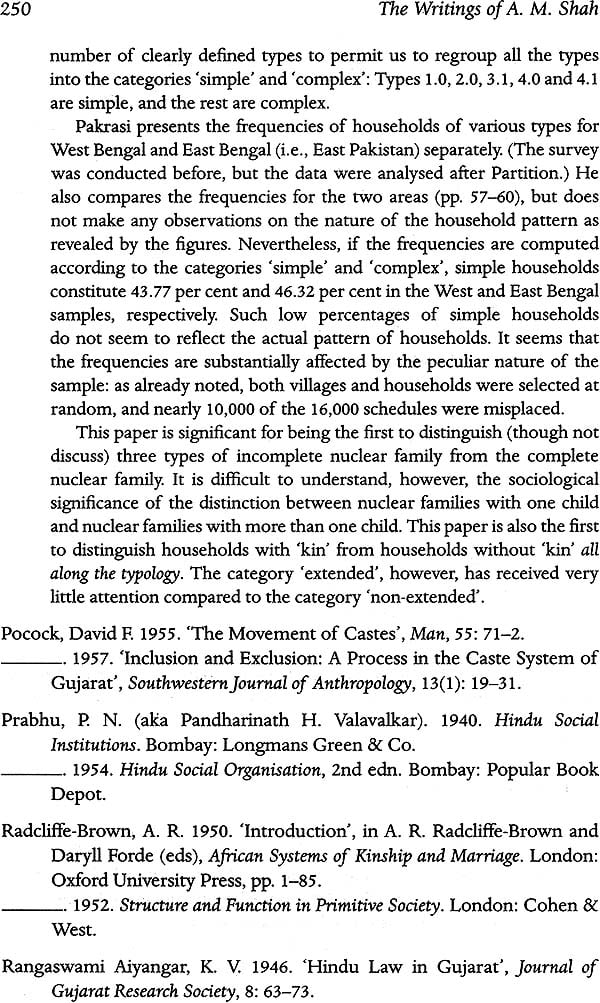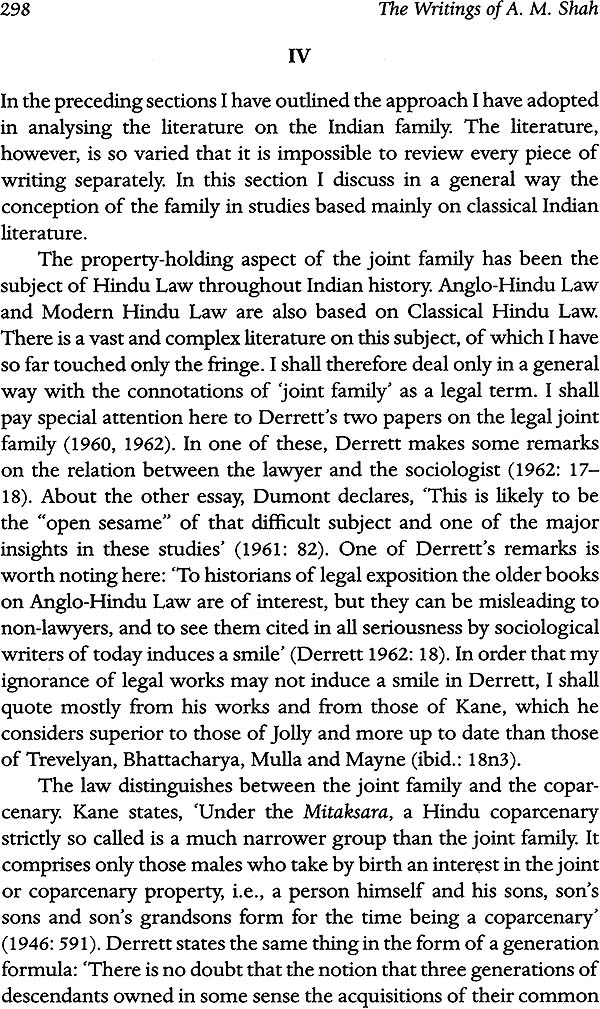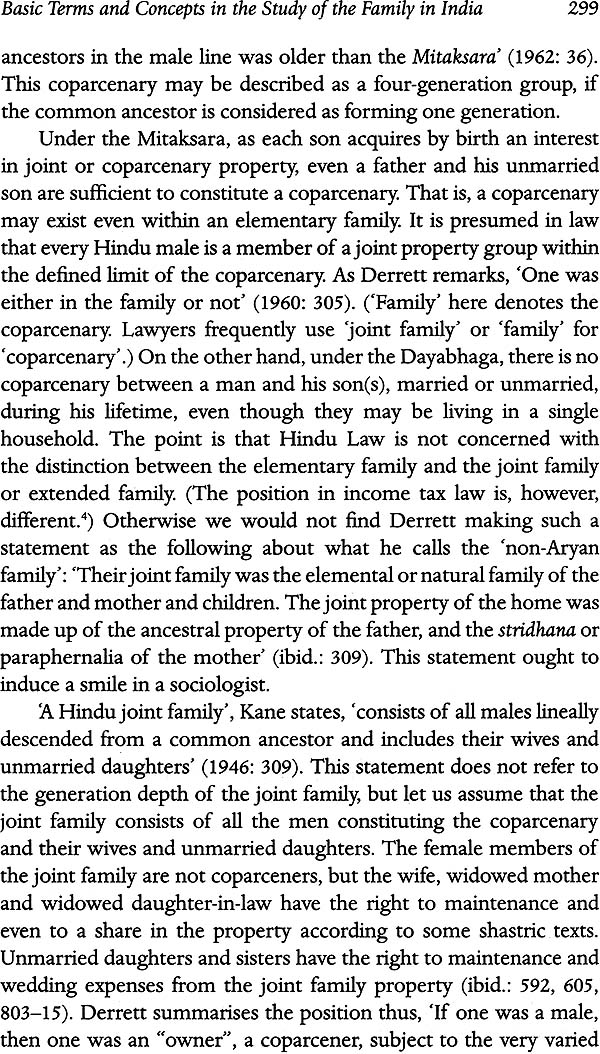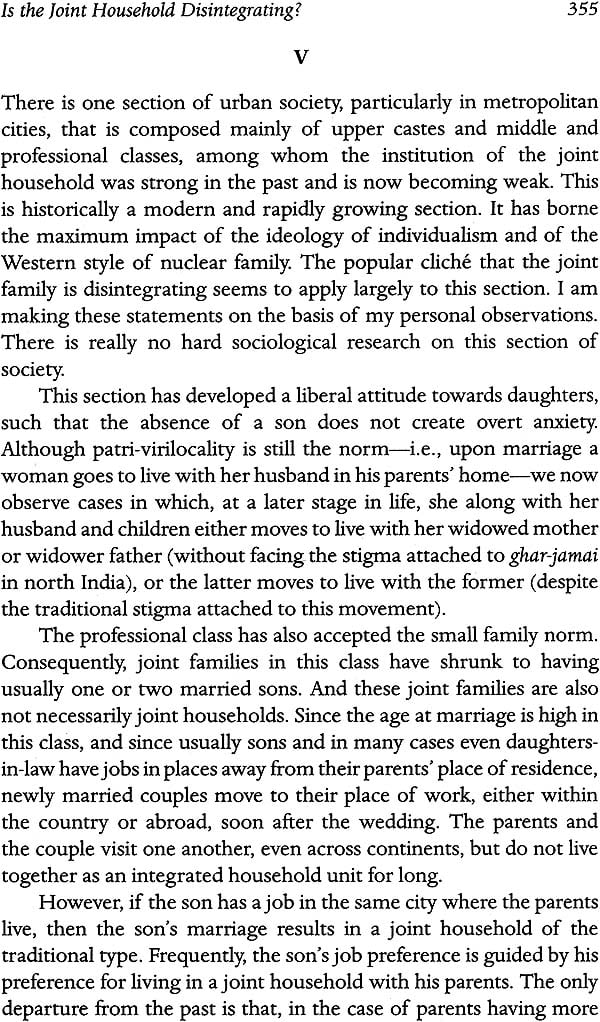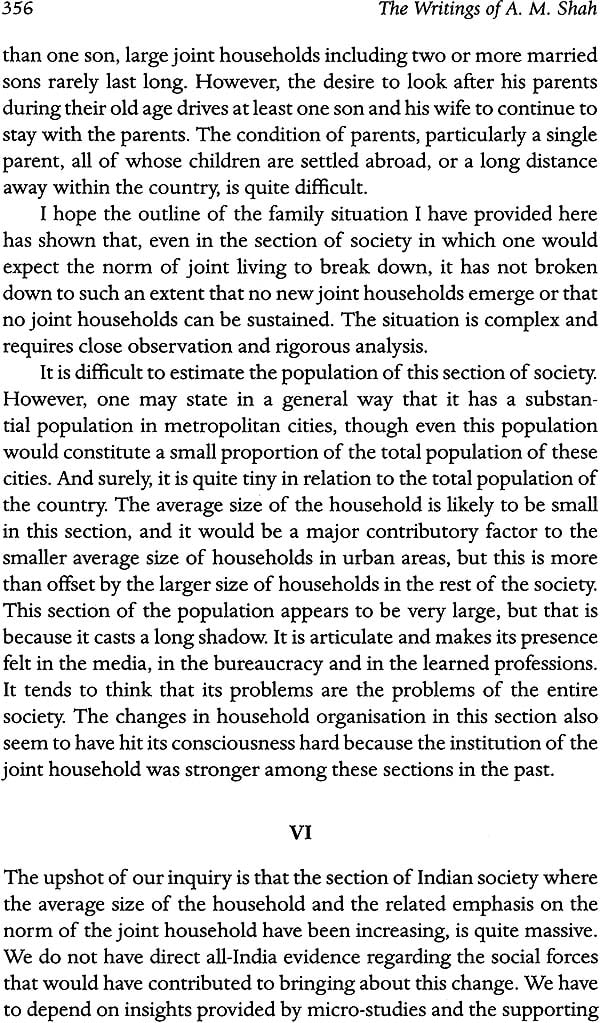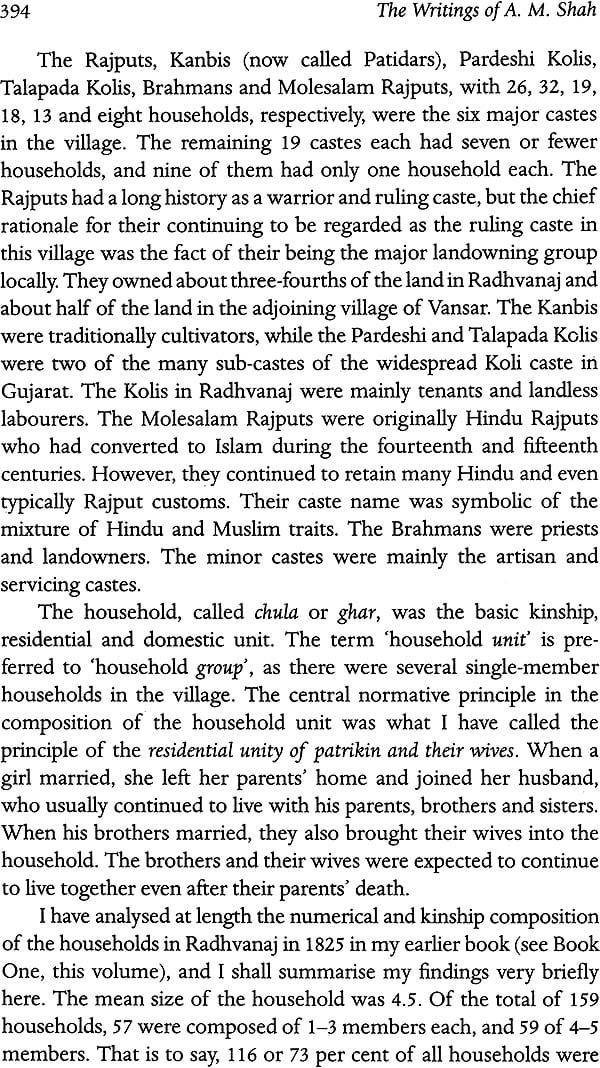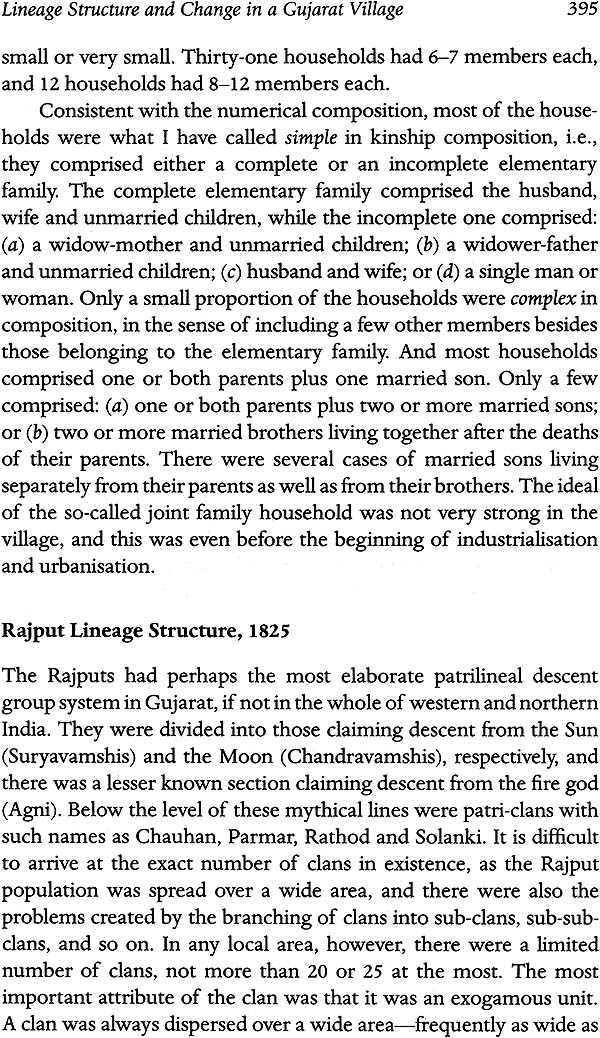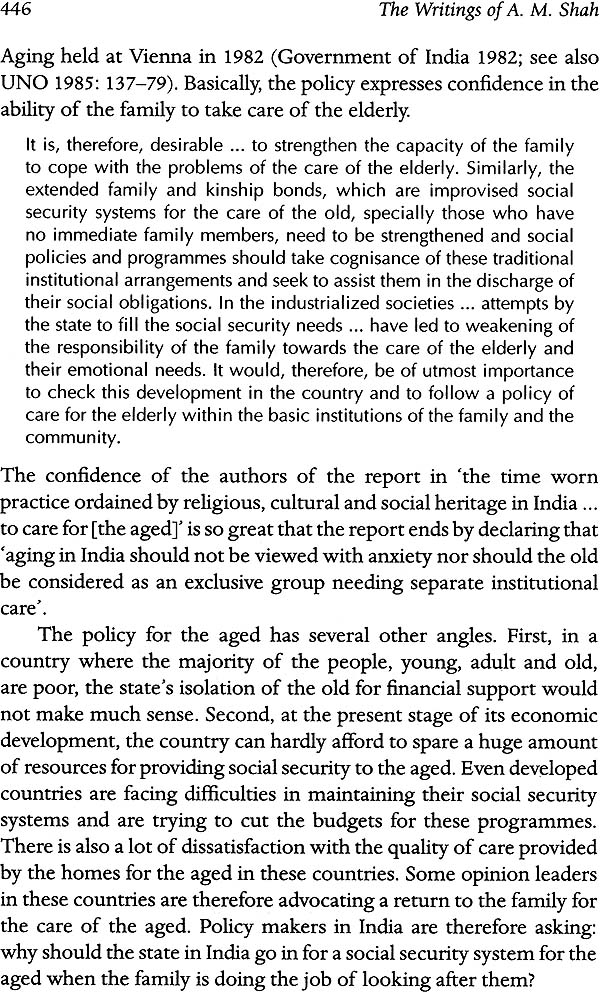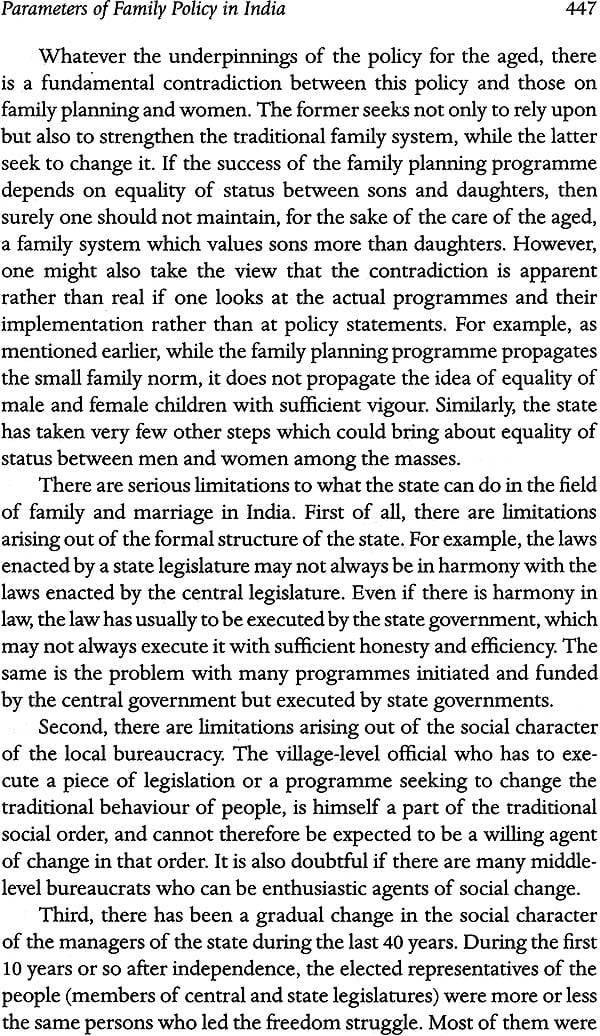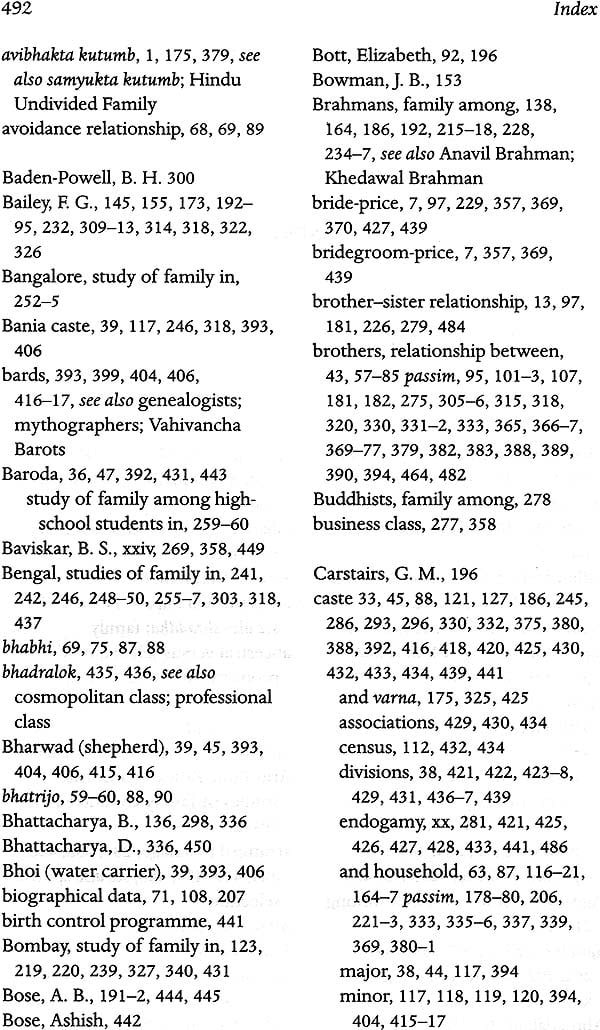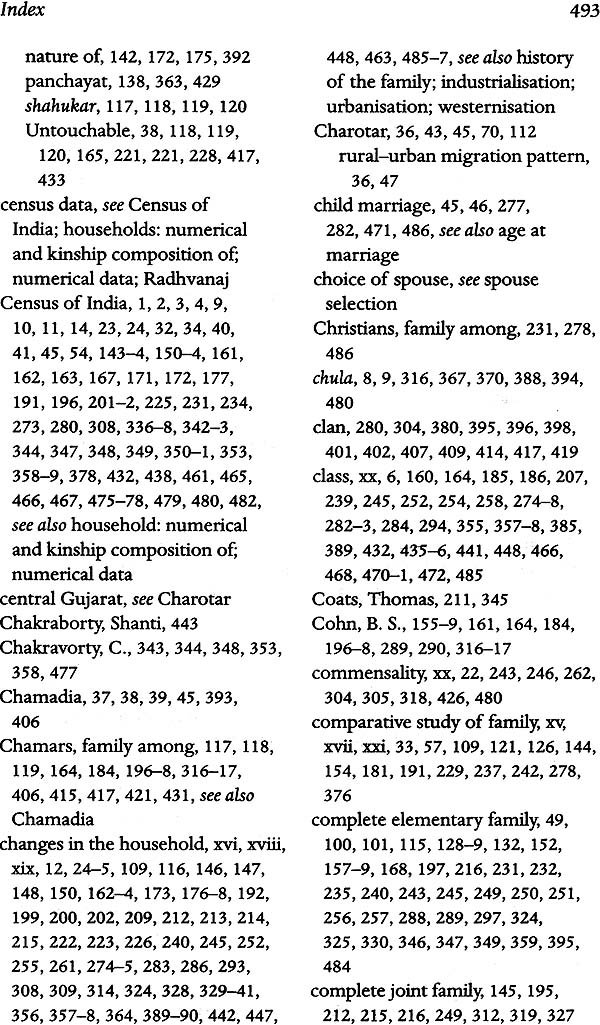
The Writings of A. M. Shah The Household and Family in India
Book Specification
| Item Code: | NAF824 |
| Author: | A. M. Shah |
| Publisher: | Orient Blackswan Pvt. Ltd. |
| Language: | English |
| Edition: | 2014 |
| ISBN: | 9788125053408 |
| Pages: | 532 |
| Cover: | Hardcover |
| Other Details | 9.0 inch X 6.0 inch |
| Weight | 710 gm |
Book Description
This volume brings together the seminal contributions of Professor A. M. Shah to the study of the family and household in India. The Household Dimension of the Family in India begins with a micro-study of households in a Gujarat village, going on to discuss broader theoretical issues attending the sociological study of the Indian family. Shah challenges through painstaking observation and analysis the entrenched stereotypes surrounding the ‘traditional’ Indian joint family and its fate in a modernizing society. Using rigorous, empirically grounded conceptual vocabularies, the book tracks the formation and organization of the household as it actually exists in practice among differently placed social groups and at various points in time.
The Family in India: Critical Essays addresses a wide range of theoretical, methodological and policy issues, including chapters on inter-household relations, the changing structure of lineage organization, caste endogamy and spouse selection, and Indian family policy.
Finally, in three more recent essays, Shah explores the effects of changes in the family on the elderly explains the relevance of census data for studies of the household, and comments on the current state of family studies in India from the perspective for his many decades of engagement with the field.
The collection will be valuable to students of family and kinship, and to sociologists, social anthropologists and demographers more generally. It will also be useful to policy makers, NGOs and institutions involved in the collection of statistical data on the family.
A. M. Shah retired as Professor, Department of Sociology, University of Delhi, in 1996.
On his own admission, Arvind Shah has devoted a great part of his professional life to ‘demystifying’ the concept of the ‘traditional Indian joint family’. This volume brings together between two covers A. M. Shah’s major writings on the family in India: The Household Dimension of the Family in India (1973), based on particular observation fieldwork in a village in central Gujarat and a comparative critical reassessment of other anthropological, sociological and historical writings on the Indian family; The family in India: Critical Essays (1998), a set of essays written over the years of two generations from 1964 to 1996; and three important later essays, ‘Changes in the Family and the Elderly’ (1999), ‘The Family in the Census of India’ (1999), and the synoptic ‘Family Studies: Retrospect and Prospect’ (2005). Viewed in its totality, we have here a unique comparative body of empirical work which is both consistent in its focus, conceptual framework and approach, and yet developing and evolving through some five decades.
The notion that Indians traditionally lived in large joint families, and its nostalgic corollary that the Indian joint family is now breaking up into nuclear family units under the impact of modernization (industrialization, urbanization, individualization, etc.), is seemingly tenaciously held by all sections of Indian society as well as Indianists abroad-professional social scientists and lay people alike. This is so despite the equivocal evidence on which the proposition rests. Based on his own detailed micro-study of family composition in village Radhvanaj (Gujarat), Shah argues that the formulation of the problem is itself seriously flawed. As the old saying goes, 'If you ask a silly question you get a silly answer.'
An empiricist to the core in his philosophy of knowledge, Shah believes that 'concepts' must emerge from the meticulous description and analysis of observed social arrangements (the inductive method, or what he calls the 'idiographic' approach), rather than from the presentation of data in terms of preconceived categories, theories and concepts (the deductive method, or what he calls the 'nomothetic' approach). 'In at least some of the fields of sociological enquiry in India', he writes, 'it is necessary for the progress of the subject to have analytical descriptions which are free from the prevalent jargon and abstractions.' What he had in mind here was the baneful influence of the 'Indological' as well as the 'legal' conceptualisations of the joint family as a ritual and property- holding group on the one hand and, on the other, the received Western social scientific understanding of modernisation as an evolutionary process that will inevitably entail progression from joint/ extended to nuclear/elementary family forms. A completely fresh start was called {or, even to the extent of devising new terms and taxonomies for understanding household types, which Shah daringly set out to do.
Following the accepted usage in professional social anthropology, Shah's point of departure was his insistence on the conceptual differentiation of family and household, the latter being defined simply as the set of persons, usually kin, who live together and share the same hearth. A social unit of production, consumption and distribution, the household so defined can be systematically enumerated and classified into sociological types, and changes in it systematically monitored over time. Indeed, the household is also now the conventional unit for the collection of demographic and socio-economic macro data, enabling cross-regional and cross- cultural comparisons and the generation of time series data. The family, on the other hand, is a very imprecise concept and inherently ambiguous. It means different things to different people, and takes different forms in different contexts. Just try asking a random set of persons, 'Who is in your family?' and you will get a wide variety of responses, from enumeration of the co-resident members of a single household; of relatives in the paternal line (agnates); of various relatives in both the paternal and maternal lines (cognates); of close relatives by marriage (affines); and no doubt many other contextually determined combinations and permutations. One thing is certain: the idea of 'the family', howsoever defined, is always emotively charged and also intrinsically linked to the articulation of community and national self-identities.
Agreed that the household, as distinct from the family, should be the focus of attention for purposes of comparative and diachronic study, there remains the analytical challenge of reducing the enormous range of empirically observed forms to a taxonomy that is both parsimonious and pertinent to the interpretation of wider social processes. The problem here is that there is simply no agreement across the available monographic field studies or survey data sets on the best mode of classifying Indian household types. Though routinely and persistently deployed in all manner of social surveys, from policy-relevant poverty surveys to titillating sex surveys, the conventional and otherwise ideologically loaded 'nuclear' /'joint' dichotomy is, in Shah's estimation, quite useless as an analytical tool. It renders opaque both the normal cyclical and the uniquely historical processes of household formation and dispersion, while eclipsing certain empirically significant forms that fail to fit the conceptual mould. Among the latter will be found the single-person household, empirically a surprisingly common phenomenon, or the frequently encountered household type composed of a married couple, with or without their children, along with a widow or widower parent. Neither unambiguously nuclear nor joint according to the usual definitions of these categories, both types of household are of special social significance, for instance, with respect to the issue of the social protection of the elderly.
Focusing attention more on process than on form and bypassing the pre-judged nuclear/joint dichotomy, Shah proposes the principle of 'the residential unity of the patrikin and their wives' as the normative basis of household progression. Wives marry in, daughters marry out, and married sons and their children remain in the parental house. Albeit a tongue-twister (though surely no worse than the anthropologist's category of 'patri-virilocal marriage"), it is this encompassing principle of motion that marks the dynamics of household growth among South Asian Hindus and also, Shah speculates, among other communities in the region as well. By contrast, the modern Western household is uniquely instituted by so-called 'neolocal marriage', that is, a husband and wife setting up a new household independent of their parental families.
While the principle of the residential unity of the patrikin and their wives is a widely held Hindu cultural ideal, endorsed by scriptural precept, it remains to be empirically demonstrated to what extent the ideal is actually followed in practice, and by which social groups in a caste-hierarchised and economically differentiated society. Shah's painstaking analysis of Radhvanaj household composition data shows that the 'expected' norm of the villagers falls rather short of the formal enunciated ideal. While marriage most usually entails the incorporation of the wife into the patrilineal household of her husband, at least initially, and while a single married son seldom separates from the parental household, households composed of married brothers are usually divided sooner or later and only very rarely survive the death of the parental generation. This having been said, other factors, especially demographic contingencies (no surviving adult son, for instance), might very well precipitate the reversal of the expected norm of the residential unity of the patrikin and their wives and disrupt the typical cyclical pattern of household progression and regression.
It is important to recognise that Shah's painstaking elaboration of the variety of Radhvanaj household types is not conceived as an end in itself. It is just the beginning of an understanding of the potentialities and complexities of interpersonal relations between individual household members within the moral economy or kinship culture of the community. At the same time, it provides the basis for a rigorous micro-level comparison with household patterns elsewhere in India, and for a systematic diachronic study of family change. Beyond this, an understanding of household composition and processes provides insight into other aspects of Indian social structure-the dynamics of the caste system in particular-as well as social processes of urbanisation, Sanskritisation, westernisation, etc. An enlightening but overlooked aspect of Shah's presentation of his village ethnography in The Household Dimension of the Family is his counter-intuitive inclusion in his village household census of 'emigrant households', that is, fragments of village households which have migrated to nearby towns but retain links (close or increasingly tenuous) with the home village. In fact, discussion of the composition of emigrant households and their structural relationship with village households actually frames his presentation and analysis of the village household data. This presentational strategy brings a new perspective to bear on the symbiotic relationship between village and town which, Shah contends, was as much a feature of 'traditional' Indian society as it is of modern times, though both the distance and the quantum of migration have no doubt expanded. Equally striking is his suggestion, even if it has remained somewhat speculative, that long-established, relatively high-caste urban communities may observe the 'Sanskritic' norms of household composition to a greater extent than the supposedly more 'traditional' rural society.
More than half a century on from the field study on which the analysis was based, The Household Dimension of the Family in India positively bristles with suggested hypotheses that still demand empirical testing. What is now the compositional structure of the rural and urban household, and the nature of the ties that bind them into enduring functional groups? Does social adherence to the ideal (or the expected) norm of the residential unity of patrikin and their wives remain strong and, if not, what are the larger social implications and consequences of the change? To what extent do the distinctive Indian regional cultures of kinship, described by social demographers and anthropologists, modulate the ideals and realities of household composition and the texture of intra-household relations? Are caste- based cultures of kinship still significant differentiators of patterns of household composition, or has the process of Sanskritisation, assisted now by universal education and the modern mass media resulted in the homogenisation of family norms, as Shah and others have recently postulated?
Starting off from his early, diligently recorded and meticulously analysed village census, A. M. Shah had left aside as atypical and grossly over-publicised the household compositional patterns and family-building ideals of the so-called 'westernised' or' cosmopolitan' segments of urban Indian society, while the impact of transnational migration on household-building strategies and structures of marriage preferences was still to become manifest. This insouciance to the political economy of class formation and globalisation is probably no longer justifiable. Shah had viewed marriage primarily in terms of adherence to or reversal of the ideal of patri-virilocality, albeit inflected by considerations of caste status, and not as an aspect of the total system of kinship and marriage transcending the household. Somehow, in the process of conceptually distinguishing the genealogically defined family from the co-resident and commensal empirical household, 'the family' itself as a multi-functional social institution had paradoxically tended to disappear from view.
In The Family in India, over a quarter-century on from The Household Dimension of the Family in India, A. M. Shah turns his attention to some of these issues: the emotional constitution of the family; relations between households; the changing structure and function of lineage organisation; the changing parameters of caste endogamy and the restructuring of caste hierarchies; the new criteria and modalities of spouse selection; the role of the elderly in Indian families; and the making of official family policy. Again, these essays are replete with observations and hypotheses that require empirical testing in the field, and the continued generation and mining of data sets.
The world over it is reported that many sociology and anthropology departments no longer teach foundational courses on family, kinship and marriage. Additionally, empirical social research is widely regarded as pertaining to large-scale macro-level surveys, not to micro-studies of small communities where qualitative research methods are deemed more appropriate and meaningful. In the Indian context, it appears that few researchers are now motivated to undertake rigorous description and analysis of household processes and family change, as A. M. Shah has done consistently through five decades or more. Glib assumptions and doomsday news-bytes have come to colonise public discourse on the family. In this context, A. M. Shah's empirical and theoretical contribution to the field of comparative studies of the household and family, consolidated in this volume, is a welcome reminder of the strength of the work that has already been done, by Shah himself and several others, and of the theoretical and pragmatic importance of taking this sceptical and empirical tradition forward.
In this volume are reproduced my two books: The Household Dimension of the Family in India: A Field Study in a Gujarat Village and a Review of Other Studies (Delhi, 1973; Berkeley, 1974); and The Family in India: Critical Essays (Delhi, 1998). Three essays published after 1998 are also included at the end of this volume. The first of the writings reproduced in this collection appeared in 1964 and the last in 2005. Two of my articles on the family are not included here: 'Family Structures', in Cheris Kramarae and Dale Spender (eds), Routledge International Encyclopedia of Women, vol. 2 (New York, 2000); and 'Family', written jointly with Tulsi Patel in Knut A. Jacobsen (ed.), Brill's Encyclopedia of Hinduism, vol. 3 (Leiden and Boston, 2011).
I thank the editor of Economic and Political Weekly for permission to reprint the articles 'Changes in the Family and the Elderly', vol. 34, no. 20 (15 May 1999), pp. 1179-82, and 'Family Studies: Retrospect and Prospect', vol. 40, no. 1 (1 January 2005), pp. 19-22, and the editor of Sociological Bulletin for permission to reprint the article 'The Family in the Census of India', vol. 48, nos 1-2, 1999, pp. 235-8.
I learned my first lesson in the systematic study of family and kinship in 1952 when Professor M. N. Srinivas asked me to assist him in conducting the household census and in drawing genealogical charts during my stay with him as his field assistant in Rampura (pseudonym) village in Karnataka. I followed the same methods during my field studies of villages and of the caste of genealogists and mythographers in Gujarat. It was perhaps because of this experience that, when I was appointed in 1958 as a teacher at the Department of Sociology, Maharaja Sayajirao University of Baroda, Srinivas asked me to teach a course on family and kinship to undergraduate students. The basic text was A. R. Radcliffe-Brown's celebrated 'Introduction' in African Systems of Kinship and Marriage (eds A. R. Radcliffe-Brown and Darryl Forde, London, 1950). Teaching it was tough, but it taught me that one had to be precise and rigorous if one wanted to study family and kinship.
When I moved to the Department of Sociology at the University of Delhi in 1961, Srinivas asked me to teach the same subject to post-graduate students. I am happy that a few of these students went on to do research on family and kinship, and made significant contributions to the discipline. I dedicate this volume to them. I thank (the late) B. S. Baviskar, Laney Lobo, Tulsi Patel and N. R. Sheth for their comments on the draft of the introduction to this volume. I also thank Vidya Rao and her associates at Orient BlackSwan, who made publication of this volume a pleasure.
The scholarly as well as popular discourse on the family in India has been dominated for long by two terms, 'joint family' and 'nuclear family', which operate like mystic mantras. I have tried to demystify them in my writings. The term 'joint family' (samyukta kutumb), or 'undivided family' (avibhakta kutumb), is ancient, elaborated in Hindu legal and liturgical texts. However, the term is concerned only with the group recognised as owning property and claiming maintenance from it and propitiating ancestors. This group is composed of the patrilineal descendants of an ancestor by three or four generations and their wives-three generations if the ancestor is excluded, and four if included. The term is not concerned with whether its members live in the same household or not-a crucial limitation. During the nineteenth century this limitation was dropped gradually, and the joint household was added as one of the characteristics of the joint family, mainly under the influence of Indologists and the officials of the Census of India. A view of the joint family as a multi-functional group thus emerged, and has survived till today.
With the beginning of British colonial rule, when the Indian family began to be compared with the Western family, the joint family was considered to be typical of India and the individual, elementary or nuclear family as typical of the West. This dichotomy continues to be integral to the discourse on the Indian family. I have, however, argued how this dichotomy comes in the way of understanding the reality of the Indian family. I shall return to this issue later. For the moment, I will continue with the discussion of the dichotomy.
In the middle of the nineteenth century, the evolutionist thinkers of Europe assumed that all Indians lived in large joint families. They placed this family on a lower rung of the ladder of social evolution and progress, and prophesied that it would eventually evolve into the nuclear family. In the twentieth century, the modernisation theorists believed that the joint family would gradually be replaced by the nuclear family under the impact of industrialisation, urbanisation and westernisation-this was actually the evolutionist view in a different garb. The Indian intelligentsia, including many social scientists, internalised this formulation. Since the mid-1950s, however, sociologists (including social anthropologists) have shown how this theory suffers from a number of conceptual and methodological infirmities, and have gone on to provide a more realistic picture of the Indian family. Nevertheless, the orthodox view continues to rule the discourse on the family in India. The officials of the Census of India of 1951 interpreted-or rather, misinterpreted-the household data according to this theory. And as recently as March 2012, after census officials presented important household data from the Census of India, 2011, at a press conference in Delhi,' the media flashed stories highlighting the orthodox theory. One story called it 'conventional wisdom'-that, as societies progress, joint families break up into nuclear families.
II
Sociological research since the clid-1950s has clearly shown that 'household' and 'family' are two different, though related, categories. The household is now used increasingly as the primary unit, not only in micro-studies by sociologists, but also in such large-scale data collections as those of the Census of India and the National Sample Survey Organisation (NSSO). However, the continuing use of the nuclear-joint family dichotomy vitiates the analysis of household data.
It is now well established in sociology that every household in patrilineal communities in India undergoes a developmental process of progression and regression-some say it is cyclical-governed by the rule of patri-virilocality. That is to say, when a girl marries she leaves her parental household and joins her husband in his parental household. The latter household progresses further when births take place and more of its male members marry. It regresses when its members die, the daughters marry and go to their husbands' homes, and separations occur between brothers and between parents and sons. Thus, at any point of time, many types of nuclear as well as joint households prevail in the society. The development of joint households and the break-up of these households into nuclear ones has always been a normal process. The popular belief that all households were once joint, and that no nuclear households existed in pre-modern India, has no basis in facts. Similarly, nuclear households are not necessarily a consequence of the influence of the Western ideology of individualism, as is generally believed.
Although many reports, both governmental and non- governmental, on small communities in different parts of India, dating back to AD 1700, showed the small numerical size of the household, Edward Gait, the census commissioner of India in 1911, was the first to question at the all-India level the orthodox view that the people of India lived in large households. He said, 'The average population per house is 4.9 or much the same as in European countries' (Census of India 1911: 47). Forty years later, in the 1951 census, the average remained almost the same at 4.8, and it was found that every third household in a village was 'small' with three members or less. The census commissioner found this' a little surprising' because, as he said, 'Such a large proportion of small households is a prima facie indication that families do not continue to be "joint" according to the traditional custom of the country.' He was repeating the orthodox theory.
When the average household size increased to 5.08 in 1961, 5.42 in 1971, 5.55 in 1981 and 5.51 in 1991, the figures challenged the theory that industrialisation, urbanisation and modernisation led to the small nuclear household. When the average decreased to 5.3 in 2001-though still higher than in 1951-the census report commented: 'This is perhaps indicative of growing nuclearization of families in the society which is more evident in urban area than in rural." More recently, in 2011, the average was 4.98, less than in 2001, suggesting nuclearisation, though it was almost the same as the average in 1911. Thus, whatever the figures, faith in the orthodox theory persists. So does the simplistic correlation between the numerical and the kinship composition of the household. Rarely is an attempt made to search for alternative explanatory variables for shifts in household size, such as changes in the birth rate, death rate, life expectancy, sex ratio, age structure, household assets (especially houses), age at marriage and changes in customs.
The handout mentioned previously, concerning households at the 2011 census, includes a table on the number of married couples in households in rural and urban areas in 2001 and 2011. I have reproduced that table here (Table I.1), and added to it the 1981 census figures for rural and urban areas together (see Book Two, Chapter 4 in this volume, for an analysis of the 1981 data). I do not have figures for 1991.
The total number of households with two or more married couples decreased from 20.37 per cent in 1981 to 18.6 per cent in 2001 and remained almost the same (18.2 per cent) in 2011. The media stories in March 2012, however, focused on the figures for 2011, and expressed surprise that not only was the number of households with two or more married couples in urban areas high, but had even increased from 14.5 per cent in 2001 to 16.3 per cent in 2011; and especially that the number of households with two couples had risen from 10.8 to 12.6 per cent. In other words, the tradition of joint households has considerable strength in urban areas, contrary to the theory that urbanisation would contribute to a weakening of the tradition. This is, however, another false theory, based in turn on the false assumption that urban areas in pre-modern India were characterised by the nuclear household typical of the West. Not only this, but much social science literature even assumes that India was a land of villages, despite the fact that India has had urban communities since the time of the Indus Valley civilisation, many centuries before Christ. All empirical evidence we have about urban communities at the beginning of the nineteenth century indicates that the emphasis on the joint household was stronger there than in villages, and for good reasons, as will be discussed at some length in this volume. If the joint household continues to be Significant in urban areas today, it should not come as a surprise.
The proportion of the urban population in India, which had remained at around 10 per cent for about a century and a half since AD 1800, has been increasing since 1951, and is now at around 35 percent. It is widely believed that this urbanisation is due to the migration of populations from rural to urban areas, which is presumed to lead to an increase in the number of nuclear households. This is not the place to discuss the complex question of urbanisation, but two points may be made about urban households. First, we have to take into account the natural growth of the population already living in the city-a considerable proportion of the population in all older cities has lived there for generations-and the greater emphasis on the joint household in this population. Second, although immigrants into a city might live in nuclear households initially, the usual progression of the developmental process of their households begins in the course of time, creating joint households in the city.
Table 1.1 shows high percentages of households with one married couple: 68 to 73 per cent in 1981-2011. The classification of households on the basis of one married couple is always a source of confusion in the literature on the Indian family, because in a large proportion of cases the household includes, besides the married couple, the husband's widowed father or mother, or unmarried brother or sister, or widowed sister, or some other relative, and yet they are called nuclear households. Since the nuclear family is defined as a group of man, wife and unmarried children, the inclusion of such a relative in it actually makes it non-nuclear. To continue to call it nuclear contradicts the definition. In fact, these households are part of the developmental process of the household in progression and regression, and should be counted as joint households. To restrict the term joint household to households containing two or more married couples is a taxonomic violation of reality. Viewed thus, the total number of joint households in urban areas would be much higher than the numbers in the table suggest-further contradicting the theory that urbanisation leads to nuclear households. The joint household is as much a part of Indian urban culture as it is of rural India.
Traditionally, the emphasis on living in the joint household is strong among the higher castes and classes, linked as it is with property, on the one hand, and with Sanskritic religion on the other. The emphasis weakens as one goes down the caste ladder, and is very weak among die lower castes and tribal communities. Not only is the regression of joint households into nuclear ones quicker among them, but newly married couples also do not always begin their married lives in the husband's parental home. Often, they live in separate huts built before the wedding in the vicinity of the parental hut and kept ready for them to occupy. In other words, it is neolocal marriage, not patri-virilocal. There can also be marriage by elopement, which would lead to neolocality. In such situations a joint household is not formed at all. Moreover, in these poorer sections of society, even if a joint household is formed, it may not survive for long due to the lack of economic assets to support it. The point is that cultural as well as economic diversities should be kept in view while interpreting macro data on the household.
Social diversities affect several other aspects of family and marriage. Traditionally, divorce and remarriage of widows are prohibited among the upper castes. However, both divorce and remarriage of widows and remarriage of divorced women are permitted among the lower castes and the tribes. Similarly, while the custom of dowry or bridegroom-price is found among the upper castes, the custom of bride-price is common among the lower castes and the tribes. The Indian intelligentsia are usually unaware of these diversities, and what they consider to be reforms for the entire society are actually reforms of their own customs. For example, while there is much agitation against the pathology of bridegroom-price, there is hardly any against the pathology of bride-price. And there is no awareness of communities that practise neither bridegroom-price nor bride- price.
It is well known that social change in India is never unidirectional. Often the trend of change in one section of society is in a direction opposite to the trend in another section. On the one hand, the spirit of individualism that has been growing among the upper castes, especially amidst the middle class, is encouraging the formation of nuclear households, thus increasing the total number of nuclear households in the country. On the other hand, social and economic changes occurring among the lower castes and tribes are encouraging the formation of joint households among them, thus offsetting the increase in the number of nuclear households. The overall ratio of joint and nuclear households in the country is not the surest indication of either the strength or the weakness of the tradition of joint household life.
III
As mentioned earlier, regression in the developmental process of a joint household may take place due to its division. Normally, married brothers set up their own separate households after their parents' deaths. However, the process of separation might begin even during their parents' lifetime, although usually at least one son Continues to stay with the parents. If the parents have only one son, normally he continues to live with them after his marriage, but he too might separate from his parents. Even after all such separations, however, the family bond continues. In the concluding part of my 1973 book The Household Dimension of the Family in India, I described 'the situation in which the members of a defined genealogical unit live in two or more households but continue to be bound by a number of other activities. It will readily be agreed that two given relatives behave in one way when they reside in a single household, and in another way when they reside in two different households' (see Book One, pp. 181-2 in this volume). A full-scale analysis of this situation based on my village data has remained for me an unfulfilled dream. I have had to be satisfied by writing three articles on this theme, 'The Phase of Dispersal in the Indian Family Process', 'Inter- household Family Relations' and 'Lineage Structure and Change in a Gujarat Village', all included in The Family in India: Critical Essays (Book Two in this volume).
I have said repeatedly that an attempt to distinguish between 'household' and 'family' should go hand in hand with observing the relationship between the two. It is absurd to think that the statistical preponderance of nuclear households is evidence of the breakdown of the joint family. The nuclear household is embedded in the joint family, if not also in the lineage. Although one brother may live in a separate household from the other, and a son may live separately from his parents, they continue to be bound by many joint activities: in property, economic enterprise, the performance of many rituals and ceremonies, mutual help in dealing with crisis situations, law (including income tax law), politics, and so on. Unfortunately, these inter-household relations within the framework of the joint family have not been studied with sufficient rigour or for different sections of society. It should be realised that the kind of massive data that are available for the household are not likely to be available for the joint family. Therefore, it is necessary to study the joint family in small communities in different parts of India and then take a comprehensive view.
IV
Normally, the household is considered to be a group of persons living in the same house (called ghar in all north Indian languages) and eating meals cooked at the same hearth (chula). However, there are also houseless households, which have a chula but not a ghar. Such households are formed by people living out in the open, for instance, nomads camping in village fields or poor people living on roadsides or pavements, under flyovers, and in other such open spaces in cities. According to the 2001 census, there were 1,943,476 such people living in 447,552 households in India. Whether the members of a household live in a house or not, they constitute a domestic group based on kinship and marriage relationships.
The household is a site where some of the deepest emotions and sentiments in human life are played out, all of which are integral to the complex web of relationships between its members. Every member is important, male or female, old or young. The web includes a large number of relationships-between father and son, father and daughter, mother and son, mother and daughter, brother and sister, mother-in-law and daughter-in-law, and so on. Every individual is involved in more than one relationship simultaneously. For example, a married son is involved in relationships with his wife, father, mother, his own sons and/ or daughters, one or more brothers, one or more sisters, etc. There are always tensions and conflicts in these relationships, which need to be kept under control to maintain harmony in the home, an ideal not always achieved in reality.
When sociologists began to conduct field studies in villages, small towns and segments of large cities around 1950, they encountered a large variety of household compositions, and not just two, nuclear and joint. They thus began to formulate typologies of households and families. Soon thereafter, demographers and census officials joined in the same enterprise. Consequently, we have now a plethora of such typologies. However, as I have pointed out many times since my 1964 essay (Shah 1964), these typologies suffer from so many infirmities that they have not helped much in advancing our understanding of the Indian family. Most of these infirmities arise out of the acceptance of the nuclear and joint families as the two archetypal forms of family. As I stated in my 1973 study, 'This is the last vestige of nineteenth-century evolutionism in the study of the Indian family, and I submit that it is necessary to get rid of it also' (see Book One, p. 174 in this volume).
Another major problem with these typologies is that everyone of them is centred on one or another category of members of the household. Most such typologies focus on males; others on women, often young married women; some on widows, ignoring widowers; and many on adults, ignoring children. The distortion of reality is thus built into everyone of these typologies. To capture reality, every member of the household and every relationship within it should be taken into account. In other words, types should be formulated as they emerge from the social reality, rather than being constructed by the scholar on the basis of preconceived notions about the nature of the Indian family. Such new types may well be called 'natural' types. They should be used to analyse household data in micro-studies, as well as the macro data of the Census of India, the NSSO and other such organisations. The number of these types is bound to be large, but will be limited by the norms of household formation, the developmental process of the household and demographic factors. Sociologists will need to search for suitable mathematical and statistical methods to carry out this analysis-interdisciplinary collaboration is highly desirable for a deeper and wider understanding of the Indian household and family.
V
In recent decades, the economic aspect of the household has received considerable attention. There are three main reasons for this. First, barring a few exceptions like hostels, every household is the primary unit of consumption. This is crucial in the study of economic inequality. For example, the acrimonious debate on the 'poverty line' is based largely on the data on household consumption. Second, the household constitutes the unit of production, with a common pool of income, in several sectors of economy, especially agriculture, handicrafts and the provision of menial services, where not only able-bodied men and women but also children and aged members of the household work as an organised group. Even if members of the household work separately and earn individual incomes, they put these incomes in the common pool. And third, the household is the beneficiary unit in the increasing number of social welfare schemes launched by the state. For example, the ordinary 'ration card' is a document that represents the household. Often, even if the beneficiary is an individual, for example, a recipient of old-age pension, s/he adds the amount of benefit to the household pool of incomes. For all these reasons, economists, policy makers and administrators need reliable data on the household. The data are generated on a massive scale by the Census of India, the NSSO and many other governmental and non-governmental institutions.
When so much household-based knowledge is required for the national economy, every effort should be made to refine continuously the methods employed to collect and process household data and the conclusions drawn from them. This may even require the integration of the household with the individual in economic theory. All in all, this would be a big job requiring collaboration among scholars in several disciplines, a collaboration in which sociologists of the family would have an important role.
This is not the place to spell out this role. However, by way of illustration, let me examine briefly the category 'head of household' used in the collection of almost all household data. First of all, let us recognise that this category is a legacy of the ancient textual view of the joint family, according to which every family had a manager (karta), who was always the senior-most male member. We have already seen the limitations of the term 'joint family' itself-such as the lack of distinction between family and household and between the various types of household compositions. In recent times, the term 'female-headed household' has been introduced to meet some of these limitations. However, some basic questions remain. Does every household have a 'head', a definitive 'head' with clearly defined functions? Do the functions of this 'head of household' cover all aspects of domestic life, or are they restricted to such matters as property and finance? Moreover, does this category exist in the consciousness of members of all households? Is it a part of their day-to-day behaviour? Or is it a construction of the investigator? That is, do members of a household become conscious of this category only when the investigator questions them about it? Being constrained to name the 'head', do they find it easy to name her / him? Even for households containing two or more adult women, a definitive response regarding the female head may not be available in every case. Moreover, even when a male or female member is named as the 'head', does it mean that s/he is the arbiter in all matters? The main problem is that the household is such a multi- functional group-a moral entity, if I may say so-that it does not have a clear distribution of power and authority. The category of the 'head of household', therefore, cannot be used as the only anchor for collecting household data. Clearly, this category requires systematic research.
VI
My study of the Indian family began, like all other studies of the family at that time, with a concern as to its forms and how they change. However, in the course of closer examination, I realised that an adequate understanding of the forms of the family required paying attention to the content of every form, i.e., the nature of interaction between members of the household-their sentiments and emotions, their pleasures and pains, their tensions and conflicts. These interactions are guided by norms and values attached to the positions and roles of the members-all members, men and women, old and young. I have tried to layout the contours of these interactions in my writings, especially in The Household Dimension of the Family in India (see Chapters 3-5). However, I have not been able to go far in this direction.
Since the publication of that book, considerable work has been done to understand the content of family life, based largely on the study of folklore, novels, autobiographies, cinema and other such sources. In this work, the field of gender studies has played a major role through exploring domestic violence, abuse of the female child, fertility behaviour, dowry deaths, the deprivation of women with regard to the inheritance of property, problems of divorce and widowhood and other themes. These studies, however, suffer from certain infirmities.
Gender studies highlight the oppression of women by men- usually some men-and ignore the oppression of women by women, quite apart from the oppression of men by women. They ignore the fact that women perform several different roles in the household, entailing the possibility of tensions and conflicts between these roles: between mother-in-law and daughter-in-law, between sisters- in-law, between mother and daughter, and between sisters.
Gender studies also suffer from inadequate consideration of the forms of family relationships. By and large, these studies consider only one or two forms. Even within the narrow confines of the nuclear family, they pay a great deal of attention to the husband-wife and parent-child relationships, and little, if any, to the brother-sister relationship. The latter is celebrated all over India as an affectionate relationship, relatively free of tensions and conflicts. This relationship also goes much beyond the nuclear family. Parallel and cross-cousins by several degrees are considered brothers and sisters. Where lineage groups prevail, all unilineal descendants of a common ancestor consider themselves brothers and sisters. Even men and women belonging to two different castes might establish fictional or ritual relationships as brothers and sisters. The relationship runs through the entire developmental process. When the sister marries and enters her conjugal home, the brother, his wife and their children acquire a set of important new relationships. Reciprocally, the sister and her husband play an important role in the lives of her nephews and nieces, especially if she is the elder sister. A widowed or divorced sister might also return to her brother's home. Moreover, this relationship occupies a crucial place in the wider network of relationships of kinship and marriage, in both north and south India, a situation that has invited complex theoretical debate and discussion for a long time (see Jamous 2003; and Trautmann 2003: 1104-26). Gender studies become poorer when they ignore kinship studies.
Those who think of relationships within the household only in demographic terms-men, women, young, old-should realise that these relationships are social in their operation. Every one of these demographic categories takes various social forms, especially in the universe of kinship and marriage. Women, for example, are wives, mothers, daughters, sisters, fathers' sisters, mothers' sisters, brothers' wives, and so on. Those who talk about the 'political economy of the household’, and that too only on the basis of demographic categories, ignore the complexities of household life.
| List of Tables and Figures | xi | |
| Foreword by Patricia Uberoi | xv | |
| Preface | xxiii | |
| Publisher's Acknowledgements | xxv | |
| Introduction | 1 | |
| BOOK ONE | ||
| The Household Dimension of the Family in India A Field Study in a Gujarat Village and a Review of Other Studies | ||
| Foreword by M. N. Srinivas | 21 | |
| Preface | 27 | |
| PART I | ||
| The Household In a Gujarat Village | ||
| Introductory Note | 31 | |
| one | Preliminary Considerations | 36 |
| two | Emigrant Households | 47 |
| three | Complex Households | 55 |
| four | Simple Households | 94 |
| five | Conspectus: The Household, Other Social Structures and Social Change | 104 |
| PART II | ||
| The Study Of The Household And Related Dimensions Of The Family In India | ||
| Introductory Note | 125 | |
| six | Basic Terms in the Sociological Study of the Indian Family | 127 |
| seven | The Indian Family in Law and Jurisprudence | 135 |
| eight | The Sociological Study of the Indian Family | 140 |
| Conclusion | 168 | |
| Glossary | 188 | |
| Annotated Bibliography | 190 | |
| BOOK TWO | ||
| The Family in India Critical Essays | ||
| Acknowledgements | 269 | |
| one | Introduction | 271 |
| two | Basic Terms and Concepts in the Study of the Family in India | 286 |
| three | Changes in the Indian Family: An Examination of Some Assumptions | 329 |
| four | Is the Joint Household Distintegrating? | 342 |
| five | The Phase of Dispersal in the Indian Family Process | 361 |
| six | Inter-household Family Relations | 378 |
| seven | Lineage Structure and Change in a Gujarat Village | 391 |
| eight | Caste Endogamy and Spouse Selection | 421 |
| nine | Parameters of Family Policy in India | 438 |
| References | 450 | |
| BOOK THREE | ||
| Essays on the Elderly and Family Studies | ||
| Introduction | 461 | |
| one | Changes in the Family and the Elderly | 463 |
| two | The Family in the Census of India | 475 |
| three | Family Studies: Retrospect and Prospect | 479 |
| References | 488 | |
| Index | 491 |
